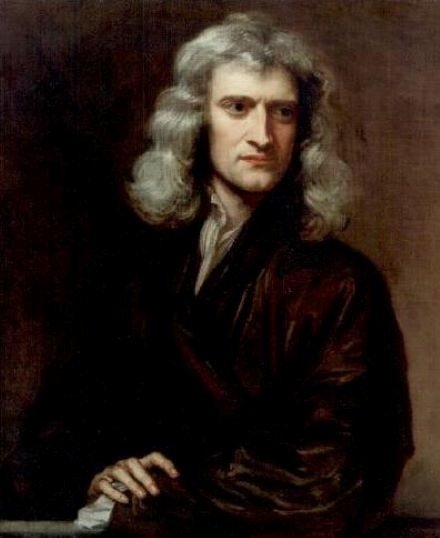The Clockwork Universe: A Deconstruction of Newton’s Laws of Motion and Gravity
Sir Isaac Newton’s Philosophiæ Naturalis Principia Mathematica, published in 1687, represents not merely a cornerstone of physics but a fundamental revolution in human thought. [1][2] It laid the groundwork for classical mechanics by codifying the principles of motion and universal gravitation, transforming the scientific landscape from one of conjecture into a discipline of mathematical rigor and empirical evidence. [1][3] Newton synthesized the work of predecessors like Galileo and Kepler, creating a comprehensive framework that explained phenomena from the terrestrial to the celestial with unprecedented accuracy. [1][4] His work established a new, systematic methodology for scientific inquiry, combining mathematical calculation with observation and experimentation, which became the standard for modern science. [3] The Principia did more than just explain the mechanics of the universe; it introduced a deterministic worldview, suggesting that the cosmos operated like a grand, predictable machine governed by immutable laws. [5][6] This powerful conception profoundly influenced not only science but also philosophy, contributing significantly to the intellectual currents of the Enlightenment. [3][7]
The Three Pillars of Motion: Inertia, Force, and Interaction
Newton’s three laws of motion form the bedrock of classical mechanics, describing the relationship between force and the resulting motion of an object. The First Law, the law of inertia, was a radical departure from Aristotelian physics, which held that motion required a continuous cause. Newton, building on Galileo’s insights, postulated that an object’s natural state is to remain at rest or to continue in uniform motion in a straight line unless compelled to change by an external force. [8][9] This principle establishes that there is no fundamental distinction between rest and uniform motion; they are equivalent states, their perception depending solely on the observer’s inertial frame of reference. [10] The philosophical implication is profound: motion is not an absolute state but a relative one, defined by the absence of net forces. The Second Law provides a quantitative definition of force itself. Originally articulated by Newton as the rate of change of “quantity of motion” (momentum), it is more commonly known by the formula F = ma. [9][11] This equation is not merely a calculation tool; it is a statement of causality, defining force as that which produces acceleration (a change in velocity), with mass acting as the measure of an object’s resistance to this change—its inertia. [12][13] The law’s more general form, F = dp/dt (Force equals the rate of change of momentum), is more robust, as it can account for systems where mass itself changes, such as a rocket burning fuel. [11][14] The Third Law, stating that for every action there is an equal and opposite reaction, completes the framework by defining the nature of interaction. [9][15] Forces never occur in isolation but always in pairs, acting on the two interacting bodies. This principle is the foundation for the law of conservation of momentum, a fundamental symmetry of nature. When a cannon fires a cannonball, the cannon recoils because the force on the ball is matched by an equal and opposite force on the cannon; the total momentum of the cannon-cannonball system remains zero. [11]
The Universal Force: Newton’s Law of Gravitation
Newton’s crowning achievement was arguably the unification of celestial and terrestrial mechanics through his law of universal gravitation. [16] He proposed that the same force causing an apple to fall to the Earth is responsible for keeping the Moon in its orbit, a revolutionary concept that erased the long-held distinction between the earthly and heavenly realms. [17] The law states that every particle of matter in the universe attracts every other particle with a force directly proportional to the product of their masses and inversely proportional to the square of the distance between their centers. [4][16] This “inverse-square law” was a brilliant insight, explaining Kepler’s empirical laws of planetary motion with mathematical precision. [2][4] It demonstrated why planets move in elliptical orbits, a puzzle that had perplexed astronomers for decades. [18] The formula, F = G(m₁m₂/r²), introduced a new fundamental constant of nature, G, the universal gravitational constant. [16] Newton himself could not determine its value, only that the law held true. It was not until 1798, over a century later, that Henry Cavendish, using an exquisitely sensitive torsion balance, first measured the faint gravitational pull between lead spheres in a laboratory setting. [19][20] Cavendish’s experiment was a triumph of precision measurement; by determining G, he not only validated Newton’s law on a terrestrial scale but also allowed for the first accurate calculation of the mass of the Earth itself. [19][21]
Legacy and Limitations: The Enduring Power of a Flawed Masterpiece
The philosophical impact of Newton’s laws was immense, fostering a mechanical philosophy that viewed the universe as deterministic and knowable through reason and mathematics. [5][13] This Newtonian worldview, where every effect has a discernible cause, dominated scientific and philosophical thought for centuries, suggesting a clockwork universe whose future states could be perfectly predicted if its present conditions were known. [6][22] However, the very success of Newtonian mechanics concealed its limitations. Its framework assumes an absolute space and time, a static backdrop against which events unfold—a notion that would be dismantled by Einstein. [5][23] The theory breaks down under extreme conditions: at velocities approaching the speed of light (the domain of Special Relativity), in the presence of immense gravitational fields (General Relativity), and at the subatomic scale (Quantum Mechanics). [10][24] In these regimes, space and time are not absolute, and the deterministic certainty of Newton’s laws gives way to the probabilistic nature of quantum phenomena. [22][25] Despite these limitations, Newton’s work remains a monumental achievement in the history of science. [2] For the vast majority of engineering and astronomical applications, from building bridges to calculating satellite trajectories, Newtonian mechanics remains an exceptionally accurate and indispensable approximation of reality. [22][24] Its legacy is not just in the equations themselves, but in establishing a paradigm for scientific inquiry that continues to shape our quest to understand the cosmos. [3]



Leave your comment
You must be logged in to post a comment.